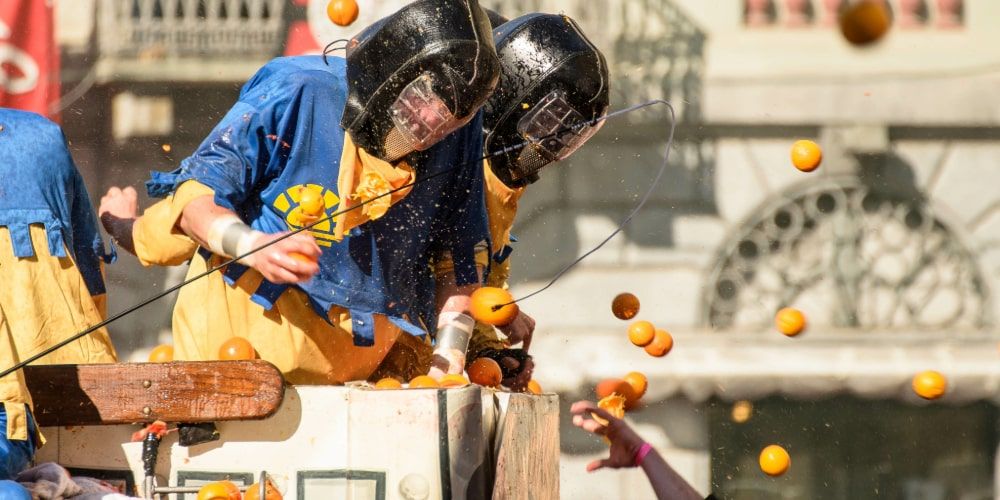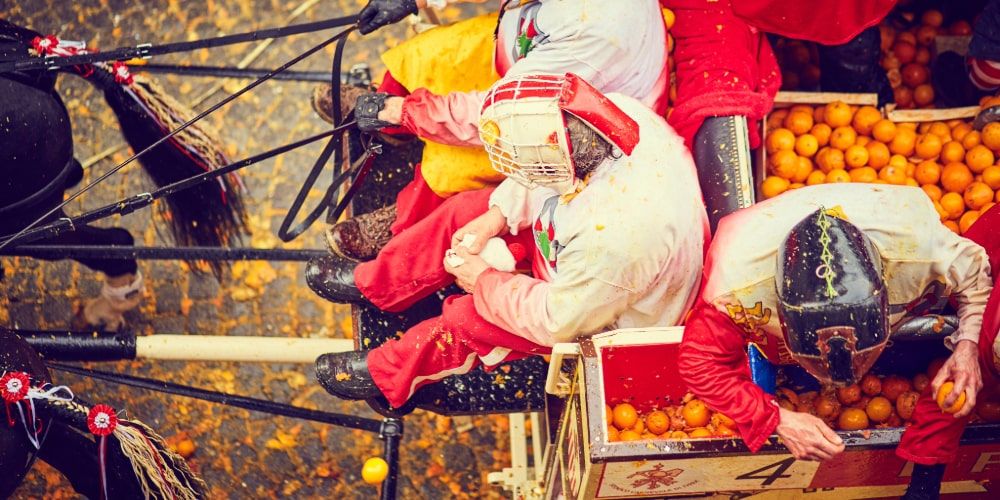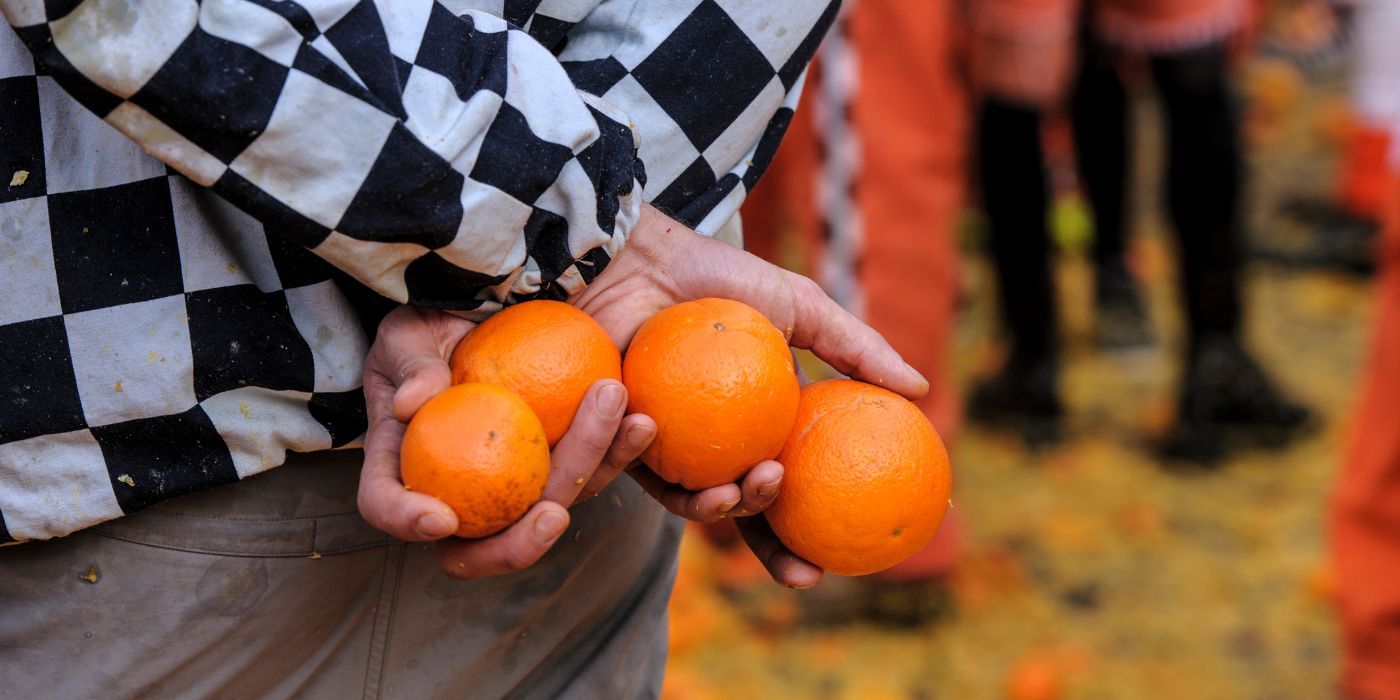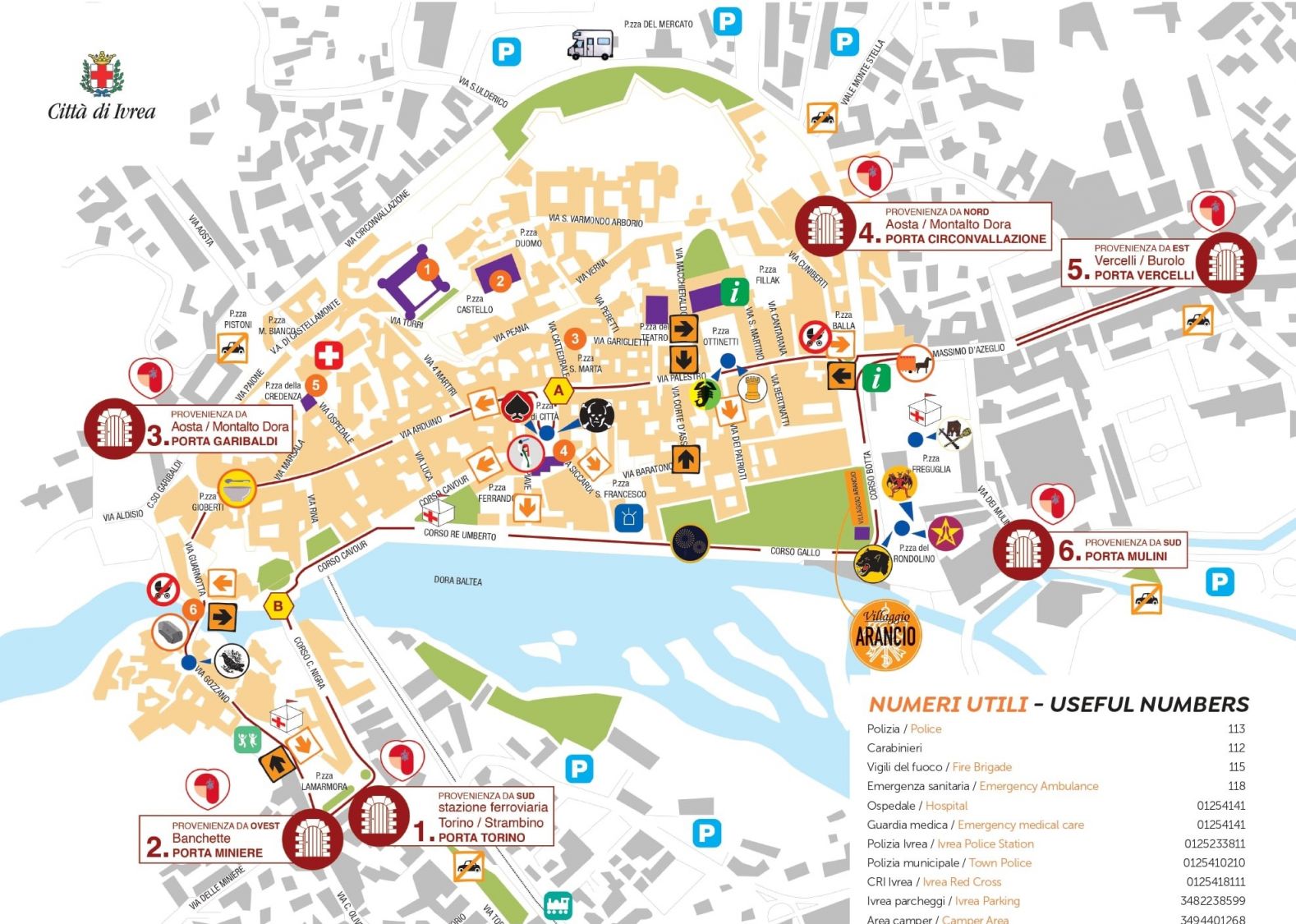Ivrea is a small town at the foot of the Piedmont Alps. Located a 40-minute drive from Turin, the city is famous for being a UNESCO World Heritage Site thanks to the glorious history of the Olivetti factory, but even more so for its characteristic Carnival.
The Historic Carnival of Ivrea is the oldest historical carnival in Italy, dating back to the Middle Ages. It is not just a folkloristic event, but a re-enactment of the popular rebellion that in 1200 deposed the tyrant and proclaimed the city a free Municipality. The rebellion is commemorated every year through a beautiful ceremonial composed of rituals and historical characters, and by the Battle of the Oranges, in which the shooters on foot, who impersonate the people, challenge the shooters on the carts, i.e. the tyrant's soldiers, by throwing oranges at each other, which resemble the stones thrown during the rebellion.

Historical Carnival of Ivrea 2025
This year, the Ivrea Carnival takes place from March 1st to March 4th, although the actual opening of the carnival period takes place on 6 January. In fact, the ceremonial is full of appointments ranging from Epiphany, the day on which the General, the male protagonist of the festival, is proclaimed, to Fat Tuesday, the closing day of the carnival with its 'funeral'.
Before delving into the programme, we believe it is important to know the history behind this important event and the main characters, so you can enter into the true spirit of Carnival!
Discover the nearby Egyptian Museum of TurinHistory and characters the Ivrea Carnival
The story behind this spectacular event is about freedom: legend has it that in the dark ages Ivrea was ruled by the Marquis of Monferrato, a tyrant who starved the city in 1200 and had established the ius primae noctis, or his right to lie with the novelties their first night of marriage. The miller's daughter decided to rebel, beheading the tyrant and showing her head to the people from the castle balcony, thus starting the rebellion against the oppressor.
From then on, the carnival tradition was passed down orally, until 1808, when something written down appeared for the first time: under Napoleonic rule, the town decided to proclaim a General to guard public order and the celebrations of the individual districts were unified into a single town festival. The General takes office on 6 January each year. You will see him parading in a black Napoleonic uniform on his horse, followed by the loyal officers of the General Staff and the Vivandiere.
But the main protagonist of the Ivrea Carnival is Violetta, the Mugnaia (miller's daughter) the heroine symbolising freedom: chosen from among the young brides each year, her identity is kept hidden until the evening of Carnival Saturday, when she is presented to the citizens from the balcony of the town hall. You will see her parading on a golden chariot, throwing confetti, candies and mimosas, traditional carnival flowers.
Among the marvellous characters in period costume that make up the procession, the Abbà are certainly the most curious: in ancient times, the Abbà was the head of the association of young people who were in charge of the festivities in each district. After the feast was unified, it was decided to recall the origin of the festivities by choosing ten children each year, two from each district: they parade in period costumes on horseback, carrying a small sword with an orange on the tip, the symbol of the tyrant's severed head.
The characteristic sound that spreads through the streets of Ivrea and ignites the carnival spirit is that of the Pifferi e Tamburi (Pipes and Drums), which accompany the characters from 6 January onwards, intoning ancient military marches and the Ivrea Carnival Song, which tells the story behind the festival in music.
Battle of the Oranges: what it is and how it comes

You read that right, this is not a metaphor: in Ivrea, during the carnival, you will witness a real battle of oranges! The Battle of Oranges is the most anticipated and engaging moment of the Ivrea Carnival, an extraordinary historical re-enactment that mixes tradition, passion and spirit of belonging.
It has its roots in the medieval legend of the revolt against the Marquis of Monferrato, who was driven out of the city by the courage of a miller’s daughter. This tradition symbolically recalls the rebellion of the people against tyranny with orange trees on foot, representing the people and fighting without protection, and the shooters on the wagons, embodying the armies of the feudal lord, protected by helmets and armor.
Over time, the battle evolved from simple throwing of beans and oranges between balconies and passers-by in the nineteenth century to becoming a real "sporting" confrontation, with organized teams and shared rules. Today, nine teams of walking orange trees, recognizable by their distinctive colours, clash with about fifty horse-drawn jet carriages.
Beyond the spectacularity and the agonism, the Battle of the Oranges is also an example of civic education and collective participation, where the city proudly defends its traditions in accordance with unwritten rules but deeply rooted in the eporediese community.
How the Battle of Oranges takes place
For three afternoons (from Sunday to Shrove Tuesday) the teams on foot, without any protection, fight against the aranceri on the floats, protected by leather helmets ('masks').
There are nine teams on foot and they divide the historical centre into fixed areas decorated with their colours, the same colours that the 'aranceri' display in their uniforms. The number of floats, which move from square to square, varies every year, and they too are decorated with identifying colours.
Here are the nine teams and the area they occupy: the Asso di Picche shoots into Piazza di Città, which it shares with the Morte. In Piazza Ottinetti we find the Scacchi and the Scorpioni d'Arduino, while the Tuchini del Borghetto are the only ones to shoot on the right bank of the Dora Baltea. In Piazza del Rondolino the Pantera Nera, the Diavoli and the Mercenari fight. Finally, the Credendari shoots in Piazza Freguglia.
Here is a handy map summarising the carnival venues:
As you will see, in Ivrea, history and legend are intertwined in a great popular festival with a strong symbolic value: everyone can participate, either by registering in one of the nine teams on foot or on the floats, or by wearing the "frigio" cap, the red sock-shaped cap that bears witness to one's adherence to the rebellion for freedom. We strongly recommend to buy your cap at one of the many stalls at the entrance to the old town, to avoid being targeted by the shooters' oranges!
Historic Carnival of Ivrea and Battle of the Oranges: 2025 programme
The Carnival of Ivrea 2025 began on Monday, January 6 with the exit of Pifferi and Tamburi in the streets of the center and the official investiture of the General in Piazza di Città. Over the course of the weeks, traditional events such as the Fagiolate will follow on Sunday 16 February and the historic ceremonies of the Prise du Drapeau and the Alzata degli Abbà, representing the city’s parishes. Thursday, February 27, the Fat Thursday will mark the official start of the celebrations with the transfer of powers from the Mayor to the General and the traditional Calzata del Berretto Frigio.
The highlight will come on Sunday, March 2, with the eagerly awaited Battle of Oranges, which will take place in the main squares of the city: Ottinetti, Town Square, Borghetto, Rondolino Square and Freguglia Square.
The celebrations will continue until Tuesday, March 4, with the evocative burning of the Scarli, symbol of purification and rebirth. The Carnival will end on Wednesday, March 5, with the traditional distribution of polenta and cod in Piazza Lamarmora, a moment of conviviality that officially closes the festival, renewing each year eporediese identity and tradition.
For more detailed information, go here.
Useful information and tips for a local experience
We know that it may seem dangerous to watch the battle, which is why we prepared a list of rules to follow in order to participate safely, plus some tips for experiencing the Ivrea Carnival as a true local:
- as we have already said, wear your Phrygian cap to avoid the unwanted attention of the aranceri.
- you can watch the battle in the squares behind metal nets, which will protect you from the oranges
- wear clothes that are comfortable, warm and can get dirty: orange juice invades the city, so better bring shoes/boots with a sole that won't make you slip!
- admission to the event is free on Monday and Tuesday, while on Sunday it costs €15.
- the local drink par excellence is mulled wine, useful for warming up! You can also find egg bombardine and schnapps tea.
- try fagioli grassi, a soup of beans and pork rinds, traditional at Piedmontese carnivals, and don't miss the distribution of polenta and codfish during Ash Wednesday!
How to get to Ivrea from Milan and Turin
.jpg)
Ivrea is 116 km from Milan, but can be easily reached by car or public transport.
If you take the A4/E64 motorway, you can reach the city in an hour and a half, or you can take the train from Milano Centrale in the direction of Chivasso and change for Ivrea (about a 3-hour journey). Although the journey is longer, the train allows you to arrive directly in the city as the station is only 15 minutes from the city centre, and allows you to avoid the traffic and parking search.
If, on the other hand, you are staying in Turin, you can easily put a visit to Ivrea during Carnival on your travel schedule, as the cities are very close and a day will suffice. The city of Ivrea is only 45 minutes by car from Turin, via the A5/E612 motorway, and an hour by train from Porta Susa or Porta Nuova.
To find out everything you can do in and from Turin during your stay, discover the Torino + Piemonte Card, the pass that allows you to visit the most beautiful attractions in the city and region free of charge, while also enjoying a discount on public transport.
Discover the Torino + Piemonte CardFAQ about the Carnival of Ivrea 2025

What is the significance of the carnival in Ivrea?
The Carnival of Ivrea symbolizes the struggle for freedom of the people against feudal tyranny, recalling the medieval revolt against the Marquis of Monferrato. Through traditions such as the Battle of the Oranges, it celebrates values of justice and collective identity, involving the community in a unique historical event.
Why are oranges being thrown at the carnival of Ivrea?
At the Carnival of Ivrea oranges are thrown to symbolically recall the rebellion of the people against the medieval tyrant. The orange trees on foot represent the people, while the shooters on the wagons represent the feudal army. The launch of oranges celebrates the struggle for freedom and eporediese identity.
When is the Ivrea 2025 carnival?
The Ivrea 2025 Carnival will take place from 6 January to 5 March, with the main events concentrated between 27 February (Thursday Fat) and 4 March (Mardi Gras). The famous Battle of Oranges will take place on 2, 3 and 4 March.
How much does it cost to make the Mugnaia at the carnival of Ivrea?
Participating in the Carnival of Ivrea as the Mugnaia involves an estimated cost between 25,000 and 30,000 euros. This covers the cost of clothing, the purchase of mimosas and sweets to be distributed during the fashion shows, as well as traditional Mugnaia-sponsored charity dinners and donations.
How much does it cost to throw oranges in Ivrea?
To participate in the Battle of Oranges as a team member, joining a team costs around 25 euros, while the compulsory uniform costs 75 euros. For spectators, entry to the battle is free on Monday and Tuesday, while a 15 euro ticket is required on Sunday.
Who is Mugnaia Ivrea 2025?
The presentation of the Vezzosa Mugnaia will take place on 1 March 2025. Its name will be revealed during the event.
Which wagon won the Carnival of Ivrea 2025?
The Ivrea 2025 Carnival will end on 5 March. The winning wagon will be announced at the end of the event.
Who are the Abba of the Carnival of Ivrea?
The Abba are children who represent the priors of the five historic parishes of Ivrea during the Carnival. They wear Renaissance costumes and participate in traditional ceremonies, such as the Alzata degli Abbà, where they are presented to the community. Their role symbolizes the festive authority and ancient city traditions.
Who is the general of Ivrea in 2025?
The General of the Historical Carnival of Ivrea 2025 is Ulisse Falchieri, class 1957, originally from Ferrara and resident in Canavese since the age of 12. He received a saber and felucca from his predecessor Alberto Bossino on 6 January 2025.
About the author
Written on 09/01/2024


.jpg)
.jpg)
.jpg)

.jpg)

Linda Zucca Bernardo
From 1 to 4 March, discover the Historic Carnival of Ivrea and experience an event unique in the world: the Battle of Oranges!